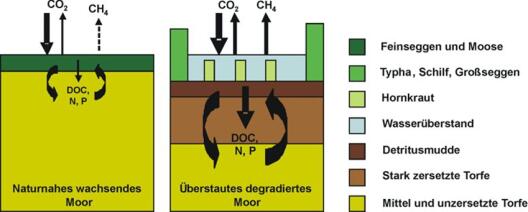Peatland Restoration Biogeochemistry
Factors controlling the release of organic matter in methonogenic, rewetted fens – stability and effects of organic matter on internal processes (KN 929/8-1)

Background
About 20 % of wetlands worldwide, 50 % in Europe, and more than 95 % of wetlands in Northeastern Germany have lost their ability to fulfill important functions in landscape water and solute fluxes, mostly due to drainage and lowering of groundwater tables. On the other hand, they now contribute about 30 % to anthropogenic CO2 emissions in the federal state of Mecklenburg-Vorpommern. Therefore, national and international initiatives have been started to restore the ecosystem functions of wetlands by rewetting. However, due to peat shrinkage and decomposition during drainage, most wetlands now have a land surface level below current groundwater tables or below adjacent water bodies. As a consequence, many rewetted areas have become shallow lakes (>> 100 ha) with a mean depth of less than 1 m. Such, often polytrophic, shallow lakes compare to littoral areas of lakes and silting up, shallow inland waters. They are dominated by dense reed and cattail and may emit extremely high amounts of methane. They have thus been suggested to be classified as new type of ecosystem (‘emerging ecosystem’).
There is still a lack of knowledge, to which extent concepts and processes studied in natural peatlands can be applied to such rewetted, inundated peatlands. Existing knowledge can only poorly explain the ongoing, strong mineralization of already strongly decomposed, earthified material on a process level. Explaining the high mineralization rates just by the high nutrient levels still lacks a mechanistic explanation behind. A clear identification of mechanisms behind the high respiration rates is thus necessary.
Methods
The project involves a combination of field and laboratory approaches. In the field, solid and liquid phase samples will be investigated in high spatial resolution; in the lab, mesocosm studies allow for controlled but near natural conditions for more detailed investigations.
Respiratory pathways will be analyzed on the process level, involving measurements of dissolved gases, electron acceptors, characterization of dissolved organic matter (FTIR, Fluorescence and UV-VIS spectroscopy, electrochemical methods), and calculations of thermodynamic conditions within the peat profile. Isotope techniques will be used on the natural abundance level and by application of tracers. In cooperation with the project partners of the Institute of Freshwater Ecology and Inland Fisheries (IGB Berlin), we will analyze enzyme activities and further characterize solid peat material and dissolved organic matter. With these approaches we aim at a more process based understanding how different restoration approaches translate into differences in the evolution of these new ecosystems.Students
Graduate and undergraduate research opportunities:
Currently, there is a master’s thesis involved in the project, comparing different restoration approaches of formerly agricultural wetlands, either with or without commercial peat extraction prior to restoration (Candidate M.Sc. Geoecology Carolin Waldemer).
Starting from summer 2014 there is the possibility to join the project and get involved as a student assistant or doing research within a BSc or MSc thesis.
For more details, especially in case of interest for a thesis or work as a student assistant, please contact Prof. Dr. Klaus-Holger Knorr.Infothek
Project partner und contact:
University of Münster
Institute for Landscape Ecology, Ecohydrology and Biogeochemistry Research Group
Principal Investigator: Prof. Dr. Klaus-Holger Knorr
Institute for Freshwater Ecology and Inland Fisheries, Berlin (IGB)
Chemical Analytics and Biogeochemistry Group
Co-Investigator: Dr. Dominik ZakProject duration and funding:
Duration: 04/2014 - 04/2017
Funded by the German Research Foundation (Deutsche Forschungsgemeinschaft, DFG KN 929/8-1).


